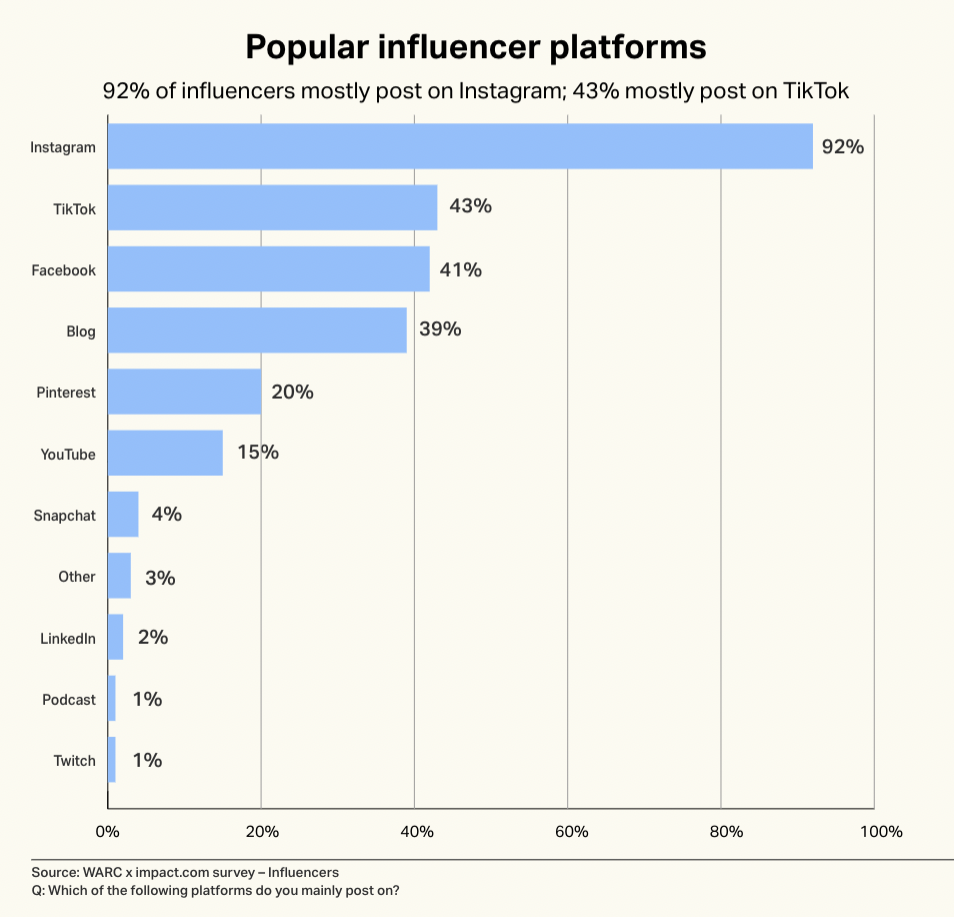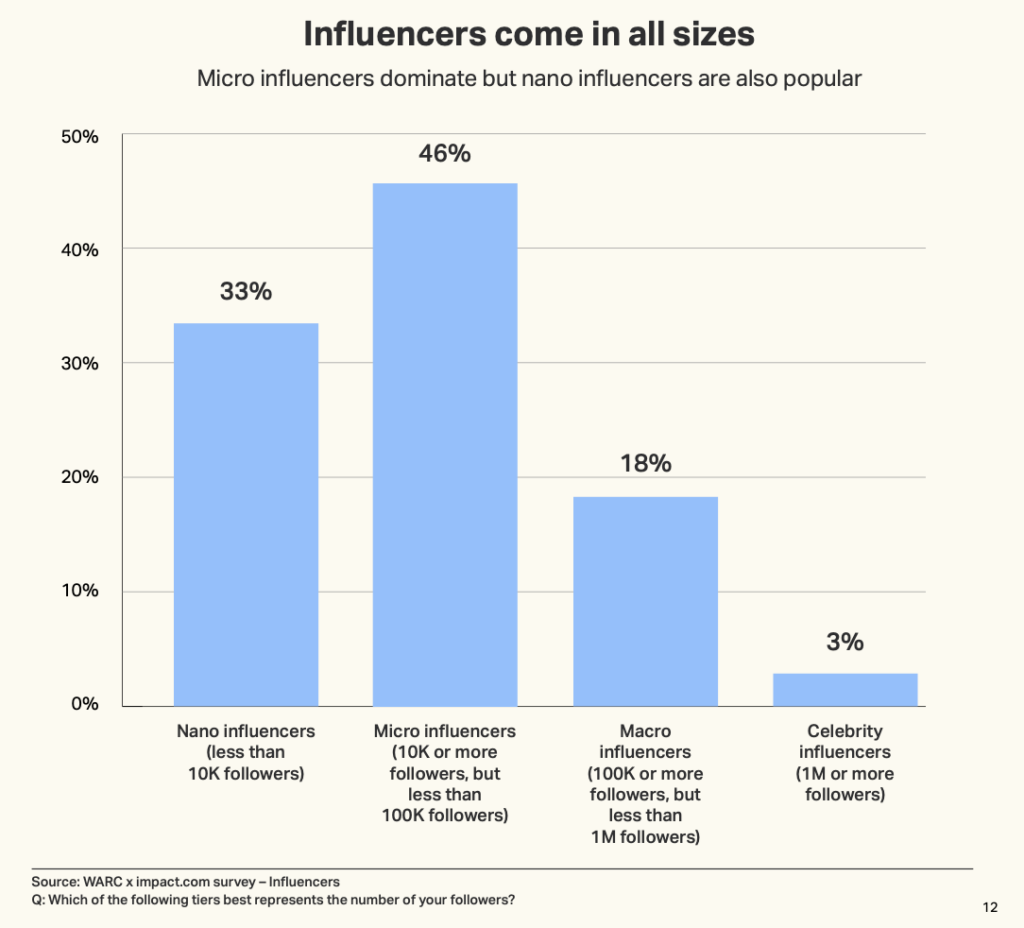5 steps to unite influencers with your marketing campaign: insights from WARC and impact’s research report
Marketers need to align their expectations with influencer partners to achieve their goals. Take a peek into the WARC research report and see how to leverage your influencer relationship for revenue growth. The post 5 steps to unite influencers with your marketing campaign: insights from WARC and impact’s research report appeared first on impact.

Picture it: it’s 2020.You’re working from home, buying your groceries online, and spending more time on social media than you care to admit. The pandemic created a new digital landscape where consumers learned to rely on trusted online resources like influencers. This change led to a surge in content creators with a deeper level of business sophistication.
Social media influencers also experimented and found innovative ways to connect with their followers (and make a sustainable living). As influencer goals shift, brands like yours have a chance to create stronger partnerships. A reported 68 percent of marketers plan to invest more in influencers this year.
Partnering with impact.com, the World Advertising Research Center (WARC) surveyed more than 800 influencers and marketers across North America, Europe, Asia, and Australia. The full report, titled “Aligning influencer and marketers: Shifting perspectives on influencer marketing across the funnel,” shows how priorities and perspectives keep shifting in influencer marketing — opening up potential challenges and opportunities. Tap into the insights ahead to best approach influencer partnerships and make investments for the long haul.
|
Betechceo's application is now open, don't miss this great opportunity for young professionals who 'Dare To Dream' Get empowered, equipped, and mentored to lead and solve problems in your country through the power of business and technology as a solution-oriented CEO. |
The shift from influencers to content creators
The number of social media influencers didn’t just go up over the last few years; the whole business model changed. Influencers also improved the quality of their content as more brands paid for endorsements and partnerships. Many subject matter experts even became popular influencers during the pandemic. In short, people engaged and monetized their online followings to become content creators. An estimated 54 percent of surveyed influencers consider themselves content creators.
Currently, 50 percent of content creators struggle to balance their creative freedom and the brand’s requirements. While 68 percent of marketers agree, it’s still a tough path to negotiate. If a content creator feels inauthentic, they’ll repel audiences no matter how closely they stick to the marketer’s goals. Audiences want to connect with the product recommendation, and have no interest in a hard sell. The value lies in influencers keeping their independence and voice.
Finding the perfect influencer partnership
Brands benefit from influencers connected authentically to an audience that matches their demographic. These creators attracted followers by promoting eye-catching content and inviting honest audience engagement. Marketers and creators can build brand trust and expand their reach by working together as partners. And it’s not just about the brands. A significant 79 percent of influencers believe healthy brand partnerships will boost their value and agency in the future — while 77 percent of their income comes from brand partnerships.
Not all influencer-brand relationships work the same way. Discovery and testing play vital roles in building long-term and successful partnerships. Marketers can use partnership management platforms (like impact.com) to discover and collaborate with influencers that fit their values. Partnerships thrive when you can track a creator’s performance and match their content with the right products.
Marketers should also define key performance indicators (KPIs) immediately, aligning influencer compensation with brand goals. Everybody wins when content creators and marketers find what works for both parties.
Compensation: show influencers the money
Like anyone putting in work, influencers expect fair and timely compensation. Gifting is no longer the only compensation model influencers should receive. When asked, 84 percent of influencers preferred a flat fee, and 59 percent of marketers found this acceptable. A hybrid model of a flat fee combined with a commission based on conversion is preferred by 47 percent of influencers, and 36 percent of marketers can agree on that method. Other compensation methods include:
- Monthly fees
- Performance bonuses
- Cost per click (CPC)
- Conversion payouts
- Tiered fees based on conversions
Starting on the right foot with influencers will motivate them in the long run and translate to better content.
The most popular influencer platforms
As marketers pinpoint content creators to partner with, it’s important to know what platforms they post on the most. Influencers post on Instagram the most (92 percent), and TikTok is proliferating, too (43 percent). These visual-heavy mediums appeal to younger audiences and can help an influencer build a steady following that could last for years.

While many marketers equate large-scale influencers with successful campaigns, that’s not always true. Brands need to consider influencers with smaller followings since they relate well with younger audiences. For example, 70 percent of teenage Youtube subscribers say they relate more to influencers than well-known celebrities. Regarding market share, micro-influencers (who have 10,000 to 100,000 followers) prove to be the most popular with audiences (46 percent).

Nano-influencers (less than 10,000 followers) connect with 33 percent of audiences, while macro-influencers (100,000 to 1 million followers) are popular with 18 percent of audiences. Celebrity influencers only hold 3 percent of consumer popularity. This is because audiences easily recognize genuine content creators — making them better options for brand partnerships and recommendations in many cases.
Followers aren’t the only consideration for brand marketers. Real engagement and audience interaction often mean more than subscriber count, particularly if you want people to follow through on recommendations and make purchases.
5 steps to align with influencers and achieve marketing success
The WARC and impact.com report demonstrate how aligning the goals and perspectives of marketers and influencers can create long-term benefits. When influencers feel like they have creative freedom, get paid fairly, and have clearly communicated goals, they create genuine content that converts. Consider these five critical steps for influencer marketing success in the future.
1. Invest in understanding influencer marketing
Now is the opportune time to invest in the influencer marketing channel. With more people shopping, connecting, and working online, culture keeps shifting in favor of content creators (and the brands who work with them).
2. Explore partnerships with influencers, external platforms, and agencies
Marketers stand the best chance of success by experimenting with different partnerships, content creators, management platforms, and outside agencies. Needs vary based on your products, services, industry size, and other factors. Brands should look for the best possible partners and solutions to manage multiple programs.
3. Approach influencer marketing as an ongoing opportunity
Short-term collaborations with influencers worked well in the past. These campaigns may have included one-time affiliate links or coupon codes. Strategies with quick wins give you a buffer while testing a partnership or working with new content creators. However, brands need to think long-term. If you drastically change directions or goals midstream, you’ll cause major issues down the road. Instead, focus on improving and optimizing partnerships over time.
4. Consider how to use influencer marketing across the entire funnel
Good content creators have established trust with their audience, which leads to higher purchase intent on the customer side. On top of other influencer marketing strategies, lean on this audience connection higher up the funnel.
5. Communicate your KPIs to influencers
Content creators should never be in the dark about the brand’s specific targets and KPIs — especially when commission payments are involved. When each party understands and agrees on vital performance metrics, influencers and marketers stand a better chance of success.
The future of influencer marketing: communication and collaboration
From a distance, content creators and brand marketers look like they have vastly different goals. But together, they help each other build sustainable businesses and connect with people on a deeper level.
The future of influencer marketing rests on communication and collaboration. Content creators feel more comfortable knowing what brands want and have the metrics to back it up. Marketers should rely on influencers to understand their audiences and create authentic brand recommendations. A platform like impact.com can help both parties find the right fit and equally benefit the entire campaign.
In the future, marketers should look beyond audience size and seek out the right partners based on deeper metrics — such as engagement and return on investment (ROI). With long-term planning and success in mind, they’ll build effective relationships with highly engaged and talented content creators. Through mutual respect and collaboration, these partnerships can withstand whatever changes are around the corner.
Get started today
Check out WARC to find out more about their efforts to demystify marketing with solid evidence. If you want to jump into influencer marketing and get started today, reach out to grow@impact.com. Read the entire impact.com and WARC report to get the full story and more insights to help you align with influencers today.
The post 5 steps to unite influencers with your marketing campaign: insights from WARC and impact.com’s research report appeared first on impact.com.





































